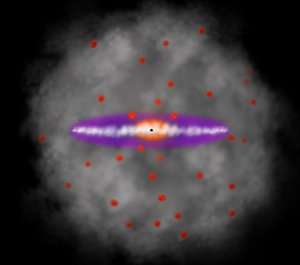Unlocking the secrets to dark matter

University of Miami astrophysicist Nico Cappelluti studies the sky. An assistant professor in the Physics Department, Cappelluti is intrigued by the cosmic phenomena of super massive black holes, the nature of dark matter, and active galactic nuclei, which is the very bright light source found at the center of many galaxies.
Recently, Cappelluti published findings that could give insight on a subject scientists and astrophysicists have been investigating for decades: What is dark matter and where does it come from?
According to Esra Bulbul, an astrophysicist at the Harvard-Smithsonian Center for Astrophysics and co-author in Cappelluti's study, about 95 percent of the mass in the universe is made up of material that is unknown and invisible to scientists, that is dark matter.
Cappelluti's study, published in The Astrophysical Journal and entitled, "Searching for the 3.5 keV line in the deep fields with Chandra: the 10 MS observations," examines an interesting light source that was captured by four different telescopes each pointing in a different direction in the sky. The source of light is unfamiliar and unrecognizable to scientists and has caused quite a stir in the world of astrophysics. Bulbul also found the emission line while studying clusters of galaxies in 2014.
"We use special telescopes to catch X-ray light in the sky, and while looking at these X-rays, the telescopes noticed an unexpected feature and captured a spectrum of light, which is not produced by any known atomic emission," said Cappelluti. "This emission line is now called the 3.5 kiloelectron volt (keV). One interpretation of this emission line is that it's produced by the decay of dark matter."
The four telescopes that captured the 3.5 keV emission were NASA's NuSTAR telescope, the European Space Agency's (ESA) XMM-Newton telescope, the Chandra telescope, and the Suzaku telescope from Japan.
"This 3.5 keV emission line is unidentified. We truly don't know what it is," said Bulbul. "But one theory is that it could be a sterile neutrino, which is also known as decaying dark matter. What is truly interesting about Dr. Cappelluti's study is that he found this 3.5 keV line within our own galaxy."
"If confirmed, this will tell us what dark matter is and could be one of the major discoveries in physics," said Cappelluti. "We know that the Milky Way is surrounded by dark matter. Think of it as if we are living in a bubble of dark matter. But we also want to have the statistical certainty of our detection, so now we are putting together a Sterile Neutrino Task Force."
This fall, several scientists from around the world, including Harvard's Bulbul, plan to gather at the University of Miami to organize a massive data-mining project to investigate and research this 3.5 keV emission line.
"The goal now is to continue to look at the sky until we obtain more powerful operating telescopes with better resolution, which won't be ready until 2021, and share and analyze data from other scientists who are trying to uncover the secrets of dark matter," said Bulbul.
More information: Searching for the 3.5 keV Line in the Deep Fields with Chandra: the 10 Ms observations, arxiv.org/abs/1701.07932
Nico Cappelluti et al. Searching for the 3.5 keV Line in the Deep Fields with Chandra: The 10 Ms Observations, The Astrophysical Journal (2018). DOI: 10.3847/1538-4357/aaaa68
Journal information: Astrophysical Journal
Provided by University of Miami




















